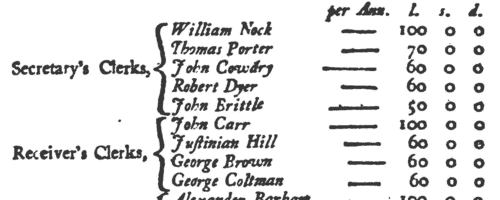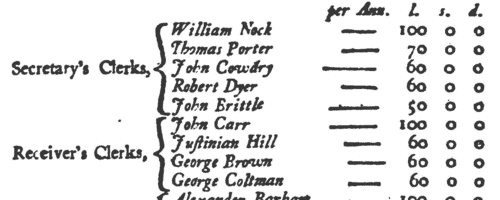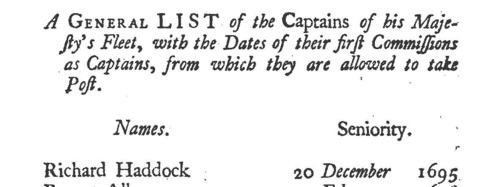Add this eBook to your basket to receive access to all 67 records. Our indexes include entries for the spelling consett. In the period you have requested, we have the following 67 records (displaying 21 to 30): These sample scans are from the original record. You will get scans of the full pages or articles where the surname you searched for has been found. Your web browser may prevent the sample windows from opening; in this case please change your browser settings to allow pop-up windows from this site.  Masters and Apprentices
(1725) Masters and Apprentices
(1725)
Apprenticeship indentures and clerks' articles were subject to a 6d or 12d per pound stamp duty: the registers of the payments usually give the master's trade, address, and occupation, and the apprentice's father's name and address, as well as details of the date and length of the apprenticeship. 16 August to 31 December 1725. | Sample scan, click to enlarge

|  Masters and Apprentices
(1733) Masters and Apprentices
(1733)
Apprenticeship indentures and clerks' articles were subject to a 6d or 12d per pound stamp duty: the registers of the payments usually give the master's trade, address, and occupation, and the apprentice's father's name and address, as well as details of the date and length of the apprenticeship. 2 January to 2 August 1733 | Sample scan, click to enlarge

| Custom House Officials
(1741)
'A General List, or Catalogue, Of all the Offices and Officers Employ'd In the several Branches of his Majesty's Government Ecclesiastical, Civil, Military, &c. In South-Britain, or England' gives the names (and often the annual salaries) of the government functionaries, civil servants, churchmen and military, systematically arranged section by section. Section 25(a) lists the commissioners, officers and others belonging to the Custom House, including the customs officers of the Port of London, at the out-ports of Sandwich, Chichester, Southampton, Poole, Plymouth, Exeter, Gloucester, Bristol, Bridgwater, Cardiff and Swansea, Milford, Ipswich, Yarmouth, Lynn, Boston, Hull, Newcastle, Berwick, Carlisle and Chester; and officers appointed by the commissioners at Rochester, Faversham, Sandwich, Deal, Dover, Rye, Shoreham, Arundel, Newhaven, Chichester, Portsmouth, Southampton, Poole, Cowes, Weymouth, Lyme, Exeter, Dartmouth, Plymouth, Looe, Fowey, Falmouth, Penryn, Truro, Penzance, St Ives, Padstow, Biddeford, Barnstaple, Ilfracombe, Minehead, Bridgwater, Bristol, Gloucester, Chepstow, Cardiff, Swansea, Milford, Llanelly, Cardigan, Aberdovey, Maldon, Colchester, Harwich, Woodbridge, Aldeburgh, Southwold, Ipswich, Yarmouth, Blakeney and Cley, Wells, Lynn, Wisbech, Boston, Hull, Bridlington, Scarborough, Whitby, Stockton, Sunderland, Newcastle, Berwick, Carlisle, Whitehaven, Lancaster, Preston and Poulton, Liverpool, Chester and Beaumaris; and in the Plantations at Carolina and the Bahamas, South Carolina, North Carolina, Roanoake, Brunswick, Virginia, Maryland, Pennsylvania, East Jersey, New York, Connecticut, New England, Bahamas, and Barbados. | Sample scan, click to enlarge

| Naval Captains
(1741)
'A General List, or Catalogue, Of all the Offices and Officers Employ'd In the several Branches of his Majesty's Government Ecclesiastical, Civil, Military, &c. In South-Britain, or England' gives the names (and often the annual salaries) of the government functionaries, civil servants, churchmen and military, systematically arranged section by section. Section 46 lists captains of his Majesty's Fleet as of 12 June 1741, with the dates of their first commissions as captains, from which they are allowed to take post. | Sample scan, click to enlarge

|  Masters and Apprentices
(1742) Masters and Apprentices
(1742)
Apprenticeship indentures and clerks' articles were subject to a 6d or 12d per pound stamp duty: the registers of the payments usually give the master's trade, address, and occupation, and the apprentice's father's name and address, as well as details of the date and length of the apprenticeship. 1 January to 31 December 1742 | Sample scan, click to enlarge

| Royal Navy Captains
(1746)
A general list of the captains of His Majesty's Fleet, with the dates of their first commissions as captains, from which they are allowed to take post. The list gives full name and exact date of seniority. | Sample scan, click to enlarge

|  Apprentices registered at York
(1757) Apprentices registered at York
(1757)
Apprenticeship indentures and clerks' articles were subject to a 6d or 12d per pound stamp duty: the registers of the payments usually give the master's trade, address, and occupation, and the apprentice's name, as well as details of the date and length of the apprenticeship. There are central registers for collections of the stamp duty in London, as well as returns from collectors in the provinces. These collectors generally received duty just from their own county, but sometimes from further afield. The indentures themselves can date from a year or two earlier than this return. (The sample entry shown on this scan is taken from a Bristol return. Each entry has two scans, the other being the facing page with the details of the indenture, length of service, and payment of duty.) IR 1/53 | Sample scan, click to enlarge

| Tradesmen of York
(1559-1759)
No man or woman could trade in the city of York without having obtained 'freedom' of the city. Their names were recorded on the 'Freemen's Roll', or Register of the Freemen of the City of York, which contains about 16,600 names for this period. A list of names was prepared for each year. Each annual list starts with the name of the mayor and the camerarii or chamberlains. The chamberlains were freemen charged with the duty of receiving the fees of the new freemen; of seeing that only freemen traded in the city; and of preparing this roll, which was compiled from the names on their own account books from the receipts for the fees. There are three groups of freemen: those who obtained freedom after serving out an apprenticeship to a freeman; the children of freemen (per patres); and a handful who claimed freedom by 'redemption', i. e. by purchase or gift from the Mayor and Court of Aldermen.
| Sample scan, click to enlarge

|  Masters of apprentices registered in York
(1767) Masters of apprentices registered in York
(1767)
Apprenticeship indentures and clerks' articles were subject to a 6d or 12d per pound stamp duty: the registers of the payments usually give the master's trade, address, and occupation, and the apprentice's name, as well as details of the date and length of the apprenticeship. There are central registers for collections of the stamp duty in London, as well as returns from collectors in the provinces. These collectors generally received duty just from their own county, but sometimes from further afield. The indentures themselves can date from a year or two earlier than this return. (The sample entry shown on this scan is taken from a Salop return. Each entry has two scans, the other being the facing page with the details of the indenture, length of service, and payment of duty.) IR 1/56 | Sample scan, click to enlarge

|  Apprentices
(1771) Apprentices
(1771)
Apprenticeship indentures and clerks' articles were subject to a 6d or 12d per pound stamp duty (late payment of the 6d rate attracted double duty (D D) of 12d): the registers of the payments usually give the master's trade, address, and occupation, and the apprentice's name, as well as details of the date and length of the apprenticeship. 18 March to 31 December 1771. | Sample scan, click to enlarge

|
Research your ancestry, family history, genealogy and one-name study by direct access to original records and archives indexed by surname.
|












